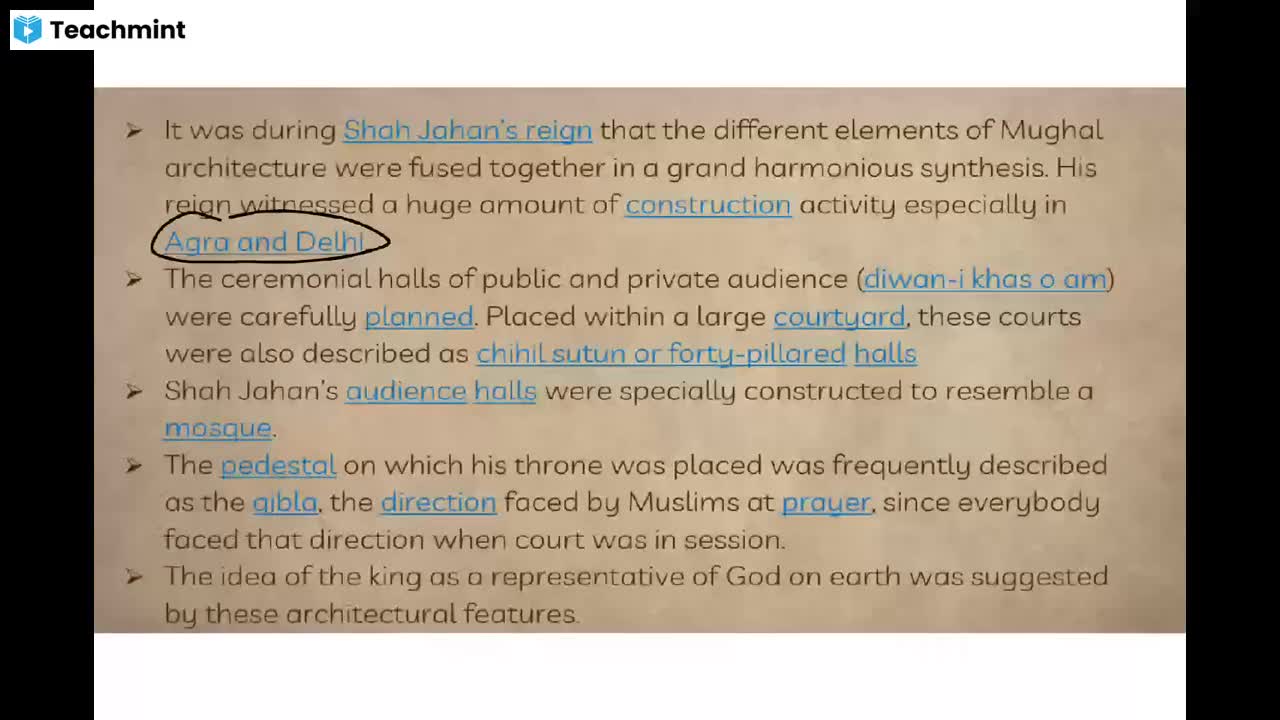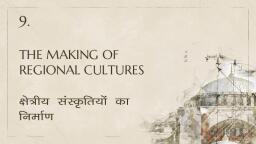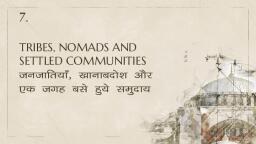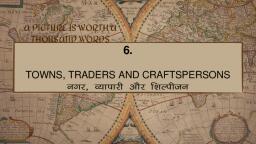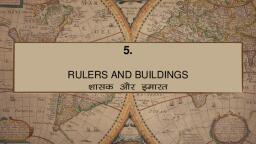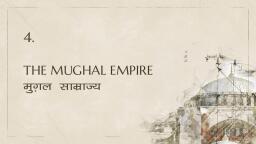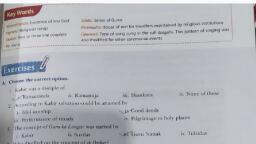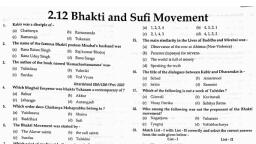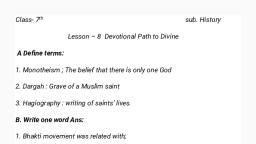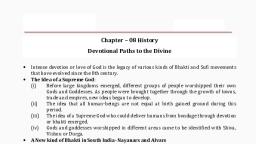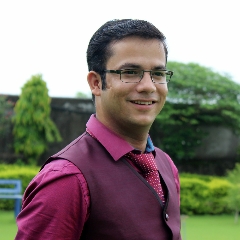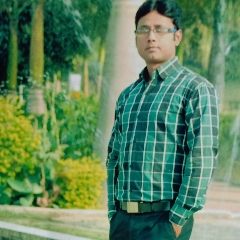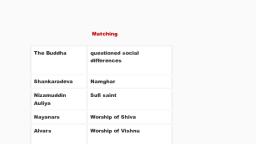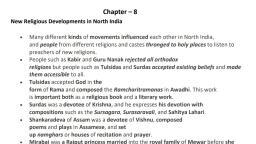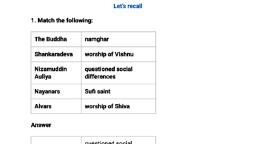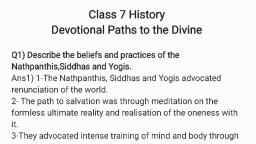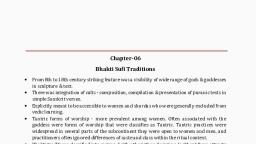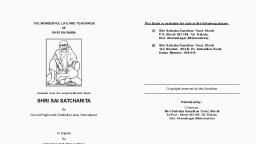Page 1 :
A PICTURE IS WORTH A, THOUSAND WORDS, , 8., DEVOTIONAL PATHS TO THE DIVINE, bZ'oj ls vuqjkx
Page 2 :
OVERVIEW ?, 1., 2., , 3., 4., 5., , 6., 7., 8., , 9., , THE IDEA OF A SUPREME GOD, A NEW KIND OF BHAKTI IN SOUTH INDIA – NAYANARS AND ALVARS, PHILOSOPHY AND BHAKTI, BASAVANNA’S VIRASHAIVISM, THE SAINTS OF MAHARASHTRA, NATHPANTHIS, SIDDHAS AND YOGIS, ISLAM AND SUFISM, NEW RELIGIOUS DEVELOPMENTS IN NORTH INDIA, A CLOSER LOOK: KABIR, BABA GURU NANAK,
Page 3 :
THE IDEA OF A SUPREME GOD, ijes'oj dk fopkj, ➢ The idea that all living things pass through countless cycles of, , birth and rebirth performing good deeds and bad came to be, widely accepted., ➢ Similarly, the idea that all human beings are not equal even at, birth gained ground during this period., ➢ The belief that social privileges came from birth in a “noble”, family or a “high” caste was the subject of many learned texts.
Page 4 :
THE IDEA OF A SUPREME GOD, ijes'oj dk fopkj, ➢ Many people were uneasy with such ideas and turned to the teachings, , of the Buddha or the Jainas according to which it was possible to, overcome social differences and break the cycle of rebirth through, personal effort, ➢ Others felt attracted to the idea of a Supreme God who could deliver, humans from such bondage if approached with devotion (or bhakti). This, idea, advocated in the Bhagavadgita, grew in popularity in the early, centuries of the Common Era.
Page 5 :
➢ Shiva, Vishnu and Durga as supreme deities came to be worshipped, , through elaborate rituals, ➢ At the same time, gods and goddesses worshipped in different areas, came to be identified with Shiva, Vishnu or Durga., ➢ In the process, local myths and legends became a part of the Puranic, , stories, and methods of worship recommended in the Puranas were, introduced into the local cults., ➢ Eventually the Puranas also laid down that it was possible for, devotees to receive the grace of God regardless of their caste status., ➢ The idea of bhakti became so popular that even Buddhists and Jainas, adopted these beliefs.
Page 7 :
A NEW KIND OF BHAKTI IN SOUTH INDIA, nf{k.k Hkkjr esa HkfDr dk ,d u;k izdkj–, NAYANARS AND ALVARS, ➢ The seventh to ninth centuries saw the emergence of new religious, , movements, led by the Nayanars (saints devoted to Shiva) and, Alvars (saints devoted to Vishnu) who came from all castes, including those considered “untouchable” like the Pulaiyar and the, Panars., ➢ They were sharply critical of the Buddhists and Jainas and, preached ardent love of Shiva or Vishnu as the path to salvation.
Page 8 :
➢ They drew upon the ideals of love and heroism as found in the, , Sangam literature, (the earliest example of Tamil literature, composed during the, early centuries of the Common Era), and blended them with the values of bhakti., ➢ The Nayanars and Alvars went from place to place composing, , exquisite poems in praise of the deities enshrined in the villages, they visited, and set them to music.
Page 9 :
➢ Between the tenth and twelfth centuries the Chola and Pandya, , kings built elaborate temples around many of the shrines visited by, the saint-poets, strengthening the links between the bhakti, tradition and temple worship., ➢ This was also the time when their poems were compiled. Besides,, hagiographies or religious biographies of the Alvars and Nayanars, were also composed, , ➢ Hagiography ( /k£ed thouh@lar thouh ys[ku), , Writing of saints’ lives.
Page 11 :
➢, , A bronze image of Manikkavasagar.., , ➢ THE DEVOTEE AND THE LORD, ➢ This is a composition of Manikkavasagar:, , Into my vile body of flesh You came, as though, it were a temple of gold, And soothed me, wholly and saved me, O Lord of Grace, O Gem, most Pure, Sorrow and birth and death and, illusion You took from me, and set me free. O, Bliss! O Light! I have taken refuge in You, And, never can I be parted from You.
Page 12 :
PHILOSOPHY AND BHAKTI, n'kZu vkSj HkfDr, ➢ Shankara, one of the most influential philosophers of India, was born, , in Kerala in the eighth century., ➢ He was an advocate of Advaita or the doctrine of the oneness of the, individual soul and the Supreme God which is the Ultimate Reality., ➢ He taught that Brahman, the only or Ultimate Reality, was formless, and without any attributes., ➢ He considered the world around us to be an illusion or maya, and, preached renunciation of the world and adoption of the path of, knowledge to understand the true nature of Brahman and attain, salvation
Page 13 :
PHILOSOPHY AND BHAKTI, n'kZu vkSj HkfDr, ➢ Ramanuja, born in Tamil Nadu in the eleventh century, was deeply, , influenced by the Alvars., ➢ According to him the best means of attaining salvation was through, intense devotion to Vishnu. Vishnu in His grace helps the devotee to, attain the bliss of union with Him., ➢ He propounded the doctrine of Vishishtadvaita or qualified oneness, in that the soul even when united with the Supreme God remained, distinct., ➢ Ramanuja’s doctrine greatly inspired the new strand of bhakti which, developed in north India subsequently
Page 15 :
VIRASHAIVA VACHANAS, ➢ These are vachanas or sayings attributed to Basavanna:, , The rich,, Will make temples for Shiva., What shall I,, A poor man, Do?, My legs are pillars,, The body the shrine,, The head a cupola, Of gold., Listen, O Lord of the meeting rivers,, Things standing shall fall,, But the moving ever shall stay.
Page 16 :
THE SAINTS OF MAHARASHTRA, egkjk"Vª ds lar, ➢ From the thirteenth to the seventeenth centuries Maharashtra saw, , a great number of saint-poets, whose songs in simple Marathi, continue to inspire people., ➢ The most important among them were Dnyaneshwar, (Gyaneshwar), Namdev, Eknath and Tukaram as well as women like, Sakhubai and the family of Chokhamela, who belonged to the, “untouchable” Mahar caste., ➢ This regional tradition of bhakti focused on the Vitthala (a form of, Vishnu) temple in Pandharpur, as well as on the notion of a personal, god residing in the hearts of all people.
Page 18 :
➢ These saint-poets rejected all forms of ritualism, outward display of, , piety and social differences based on birth., ➢ In fact they even rejected the idea of renunciation and preferred to, live with their families, earning their livelihood like any other person,, while humbly serving fellow human beings in need., ➢ A new humanist idea emerged as they insisted that bhakti lay in, , sharing others’ pain., ➢ As the famous Gujarati saint Narsi Mehta said,, “They are Vaishnavas who understand the pain of others.”
Page 20 :
QUESTIONING THE SOCIAL ORDER, ➢ This is an abhang (Marathi devotional hymn) of Sant Tukaram:, , He who identifies, with the battered and the beaten, Mark him as a saint, For God is with him, He holds Every forsaken man, Close to his heart, He treats, A slave, As his own son Says, Tuka I won’t be tired to repeat again, Such a man Is God In person.
Page 21 :
➢ Here is an abhang composed by Chokhamela’s son :, , You made us low caste,, Why don’t you face that fact, Great Lord?, Our whole life – left-over food to eat., You should be ashamed of this., You have eaten in our home., How can you deny it?, Chokha’s (son) Karmamela asks, Why did you give me life?
Page 22 :
NATHPANTHIS, SIDDHAS AND YOGIS, ukFkiaFkh] fl)I vkSj ;ksxh, ➢ A number of religious groups that emerged during this period, , criticised the ritual and other aspects of conventional religion and, the social order, using simple, logical arguments., ➢ Among them were the Nathpanthis, Siddhacharas and Yogis., ➢ They advocated renunciation of the world., ➢ To them the path to salvation lay in meditation on the formless, , Ultimate Reality and the realisation of oneness with it.
Page 23 :
➢, , ➢, , ➢, , To achieve this they advocated intense training of the, mind and body through practices like yogasanas,, breathing exercises and meditation., These groups became particularly popular among “low”, castes., Their criticism of conventional religion created the, ground for devotional religion to become a popular force, in northern India
Page 25 :
ISLAM AND SUFISM( bLyke vkSj lwQh er), ➢ The sants had much in common with the Sufis, so much so that it is, , believed that they adopted many ideas of each other., ➢ Sufis were Muslim mystics. They rejected outward religiosity and, , emphasised love and devotion to God and compassion towards all, fellow human beings., ➢ Islam propagated strict monotheism or submission to one God. In the, , eighth and ninth centuries religious scholars developed different aspects, of the Holy Law (Shariat) and theology of Islam. While the religion of, Islam gradually became more complex,
Page 26 :
➢ Sufis provided it with an additional dimension that favoured a more, , personal devotion to God., ➢ The Sufis often rejected the elaborate rituals and codes of behaviour, demanded by Muslim religious scholars., ➢ They sought union with God much as a lover seeks his beloved with a, disregard for the world., ➢ Like the saint-poets, the Sufis too composed poems expressing their, , feelings, and a rich literature in prose, including anecdotes and fables,, developed around them., ➢ Among the great Sufis of Central Asia were Ghazzali, Rumi and Sadi. Like, the Nathpanthis, Siddhas and Yogis, the Sufis too believed that the heart, can be trained to look at the world in a different way.
Page 27 :
➢ Sufis developed elaborate methods of training using, , zikr (chanting of a name or sacred formula),, contemplation,, sama (singing),, raqs (dancing),, discussion of parables,, breath control, etc., under the guidance of a master or pir., ➢ Thus emerged the silsilas, a spiritual genealogy of Sufi teachers, each, , following a slightly different method (tariqa) of instruction and ritual, practice.
Page 31 :
➢ The Sufi masters held their assemblies in their khanqahs or, , hospices., ( Hospice ( [+kkuDkg), House of rest for travellers, especially one kept by a, religious order), ➢ Devotees of all descriptions including members of the royalty, and nobility, and ordinary people flocked to these khanqahs., ➢ They discussed spiritual matters, sought the blessings of the, , saints in solving their worldly problems, or simply attended the, music and dance sessions.
Page 32 :
➢ Often people attributed Sufi masters with miraculous powers, , that could relieve others of their illnesses and troubles., ➢ The tomb or dargah of a Sufi saint, became a place of pilgrimage to which, thousands of people of all faiths thronged., , Devotees of all backgrounds visit Sufi shrines.
Page 33 :
FINDING THE LORD (izHkq dh [kkst), ➢ Jalaluddin Rumi was a great thirteenth-century Sufi poet from Iran who, , wrote in Persian. Here is an excerpt from his work:, ➢ He was not on the Cross of the Christians. I went to the Hindu temples. In, , none of them was there any sign. He was not on the heights or in the, lowlands … I went to the Kaaba of Mecca. He was not there. I asked, about him from Avicenna the philosopher. He was beyond the range of, Avicenna … I looked into my heart. In that, his place, I saw him. He was in, no other place.
Page 34 :
NEW RELIGIOUS DEVELOPMENTS IN, NORTH INDIA (mÙkj Hkkjr), ➢ An age(13TH CENTURY) when Islam, Brahmanical Hinduism,, , Sufism, various strands of bhakti, and the Nathpanths, Siddhas, and Yogis influenced one another., ➢ New towns and kingdoms were emerging, and people were, taking up new professions and finding new roles for themselves., Such people, especially craftspersons, peasants, traders and, labourers, thronged to listen to these new saints and spread, their ideas,
Page 35 :
➢ Some of them like Kabir and Baba Guru Nanak rejected all, , orthodox religions. Others like Tulsidas and Surdas accepted, existing beliefs and practices but wanted to make these, accessible to all., ➢ Tulsidas conceived of God in the form of Rama. Tulsidas’s, , composition, the Ramcharitmanas, written in Awadhi (a, language used in eastern Uttar Pradesh), is important both as, an expression of his devotion and as a literary work., ➢ Surdas was an ardent devotee of Krishna. His compositions,, , compiled in the Sursagara, Surasaravali and Sahitya Lahari,, express his devotion.
Page 36 :
➢ Also contemporary was Shankaradeva of Assam (late fifteenth, , century) who emphasised devotion to Vishnu, and composed poems, and plays in Assamese., ➢ He began the practice of setting up namghars or houses of recitation, and prayer, a practice that continues to date., ➢ The essence of Shankaradeva’s devotion came to be known as Eka, , Sarana Nama Dharma (supreme surrender to the One)., ➢ The teachings of Shankaradeva were based on the Bhagavad Gita and, Bhagavata Purana., ➢ He also encouraged the establishment of satra or monasteries for, transmission of knowledge., ➢ His major compositions included Kirtana-ghosha.
Page 37 :
➢ This tradition also included saints like Dadu Dayal, Ravidas and, , Mirabai., ➢ Mirabai was a Rajput princess married into the royal family of, , Mewar in the sixteenth century. Mirabai became a disciple of, Ravidas, a saint from a caste considered “untouchable”., ➢ She was devoted to Krishna and composed innumerable bhajans, expressing her intense devotion., ➢ Her songs also openly challenged the norms of the “upper”, castes and became popular with the masses in Rajasthan and, Gujarat.
Page 38 :
BEYOND THE RANA’S PALACE, This is a song composed by Mirabai:, Ranaji, I have left your norms of shame,, and false decorum of the princely life., I have left your town., And yet Rana why have you kept up enmity against me?, Rana you gave me a cup of poison., I drank it laughing., Rana I will not be destroyed by you., And yet Rana why have you kept up enmity against me?
Page 39 :
➢ A unique feature of most of the saints is that their works were, , composed in regional languages and could be sung., ➢ They became immensely popular and were handed down orally, from generation to generation., ➢ Usually the poorest, most deprived communities and women, , transmitted these songs, often adding their own experiences., ➢ Thus the songs as we have them today are as much a creation of, , the saints as of generations of people who sang them. They have, become a part of our living popular culture
Page 40 :
➢ An important contribution of Bhakti saints was towards the, , development of music., ➢ Jayadeva of Bengal composed the Gita Govinda in Sanskrit,, each song composed in a particular raga and tala., ➢ A significant impact that these saints had on music was the, , use of bhajan, kirtan and abhang., ➢ These songs which emphasised on emotional experience had a, tremendous appeal to the common people.
Page 41 :
➢ Chaitanyadeva, a sixteenth-, , century bhakti saint from, Bengal, preached selfless, devotion to Krishna-Radha., ➢ In the picture you see a group, , of his followers engaged in, ecstatic dancing and singing.
Page 42 :
➢ Major bhakti, , saints and, the regions, associated, with them.
Page 43 :
A CLOSER LOOK: KABIR, ➢ He was brought up in a family of Muslim julahas or weavers settled, , in or near the city of Benares (Varanasi)., ➢ We get to know of his ideas from a vast collection of verses called, , sakhis and pads said to have been composed by him and sung by, wandering bhajan singers., ➢ Some of these were later collected and preserved in the Guru, Granth Sahib, Panch Vani and Bijak., ➢ The language of his poetry was a form of spoken Hindi widely, , understood by ordinary people. He also sometimes used cryptic, language, which is difficult to follow.
Page 44 :
A CLOSER LOOK: KABIR, ➢ Kabir’s teachings were based on a complete, indeed vehement,, , rejection of the major religious traditions., ➢ His teachings openly ridiculed all forms of external worship of both, Brahmanical Hinduism and Islam, the pre-eminence of the priestly, classes and the caste system., ➢ Kabir believed in a formless Supreme God and preached that the, , only path to salvation was through bhakti or devotion., ➢ Kabir drew his followers from among both Hindus and Muslims
Page 46 :
A CLOSER LOOK: BABA GURU NANAK, (1469-1539), ➢ Born at Talwandi (Nankana Sahib in Pakistan), he travelled widely, , before establishing a centre at Kartarpur (Dera Baba Nanak on, the river Ravi)., ➢ A regular worship that consisted of the singing of his own hymns, was established there for his followers. Irrespective of their former, creed, caste or gender, his followers ate together in the common, kitchen (langar)., ➢ The sacred space thus created by Baba Guru Nanak was known, as dharmsal. It is now known as Gurdwara.
Page 47 :
➢ Before his death in 1539, Baba Guru Nanak appointed one of, , his followers as his successor., ➢ His name was Lehna but he came to be known as Guru Angad,, signifying that he was a part of Baba Guru Nanak himself., ➢ Guru Angad compiled the compositions of Baba Guru Nanak,, to which he added his own in a new script known as Gurmukhi., ➢ The three successors of Guru Angad also wrote under the, , name of “Nanak” and all of their compositions were compiled, by Guru Arjan in 1604.
Page 48 :
➢ Baba Guru Nanak, , as a young man, in, discussion with, holy men.
Page 49 :
➢ To this compilation were added the writings of other figures, , like Shaikh Farid, Sant Kabir, Bhagat Namdev and Guru Tegh, Bahadur., ➢ In 1706 this compilation was authenticated by Guru Tegh, Bahadur’s son and successor, Guru Gobind Singh. It is now, known as Guru Granth Sahib, the holy scripture of the Sikhs., ➢ The number of Baba Guru Nanak’s followers increased, , through the sixteenth century under his successors., ➢ They belonged to a number of castes but traders,, agriculturists, artisans and craftsmen predominated.
Page 50 :
➢ Followers increased because of Baba Guru Nanak’s insistence, , that his followers must be householders and should adopt, productive and useful occupations., ➢ They were also expected to contribute to the general funds of, the community of followers., ➢ By the beginning of the seventeenth century the town of, , Ramdaspur (Amritsar) had developed around the central, Gurdwara called Harmandar Sahib (Golden Temple)., ➢ It was virtually self-governing and modern historians refer to, the early-seventeenth-century Sikh community as ‘a state, within the state’.
Page 51 :
➢ The Mughal emperor Jahangir looked upon them as a, , potential threat and he ordered the execution of Guru Arjan in, 1606., ➢ The Sikh movement began to get politicised in the seventeenth, century, a development which culminated in the institution of, the Khalsa by Guru Gobind Singh in 1699., ➢ The community of the Sikhs, called the Khalsa Panth, became a, political entity., ➢ The changing historical situation during the sixteenth and, , seventeenth centuries influenced the development of the Sikh, movement.
Page 52 :
➢ The ideas of Baba Guru Nanak had a huge impact on this, , development from the very beginning., ➢ He emphasised the importance of the worship of one God., ➢ He insisted that caste, creed or gender was irrelevant for attaining, , liberation., ➢ His idea of liberation was not that of a state of inert bliss but rather, the pursuit of active life with a strong sense of social commitment., ➢ He himself used the terms nam, dan and isnan for the essence of, , his teaching, which actually meant right worship, welfare of others, and purity of conduct
Page 53 :
➢ His teachings are now remembered as nam-japna, kirt-karna and, , vandchhakna, which also underline the importance of right belief, and worship, honest living, and helping others., ➢ Thus, Baba Guru Nanak’s idea of equality had social and political, , implications., ➢ This might partly explain the difference between the history of the, , followers of Baba Guru Nanak and the history of the followers of, the other religious figures of the medieval centuries, like Kabir,, Ravidas and Dadu whose ideas were very similar to those of Baba, Guru Nanak.
Page 54 :
➢ An early, , manuscript, of the Guru, Granth Sahib.
Page 55 :
MARTIN LUTHER AND THE REFORMATION, ekfVZu ywFkj vkSj /IeZlq/kj vkanksyu, ➢ The sixteenth century was a time of religious ferment in Europe as, , well., ➢ One of the most important leaders of the changes that took place, within Christianity was Martin Luther (1483-1546)., ➢ Luther felt that several practices in the Roman Catholic Church, , went against the teachings of the Bible., ➢ He encouraged the use of the language of ordinary people rather, than Latin, and translated the Bible into German.
Page 56 :
MARTIN LUTHER AND THE REFORMATION, ekfVZu ywFkj vkSj /IeZlq/kj vkanksyu, ➢ Luther was strongly opposed to the practice of “indulgences”, , or making donations to the Church so as to gain forgiveness, from sins., ➢ His writings were widely disseminated with the growing use, of the printing press., ➢ Many Protestant Christian sects trace their origins to the, teachings of Luther
Page 60 :
THANKS !



